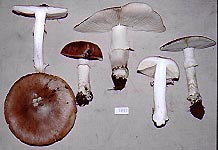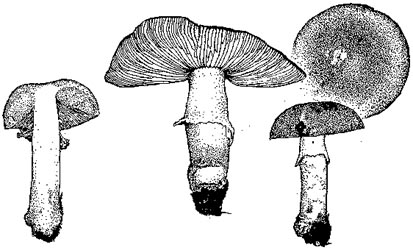|
[ Section Amanita page. ]
[ Amanita Studies home. ]
[ Keys & Checklist/Picturebooks ] "Gray Bride's Veil Amanita"
Technical description (t.b.d.) BRIEF DESCRIPTION: Amanita murinoflammeum was originally believed to be a species of Amanita sect. Vaginatae. As yet unpublished molecular results (J.-M. Moncalvo, pers. corresp.) provoked a re-evaluation; and both molecular and morphological data show that this taxon should be placed in sect. Amanita. Its cap is 85 - 140 mm wide, light reddish brown when young, becoming light brown, when expanded, having margin with short striations (length about 15% of radius). The volva may be absent from the cap or present as whitish to pale gray warts, becoming darker gray with age. The gills are free to adnexed, close, off-white with a faint yellow or cream tint at first; lamellulae are more or less truncate, plentiful, of varying length, and between every pair of lamellae in some basidiocarps. The stem is 80 - 110 × 15 - 30 mm, cylindric or slightly narrowing upward or broadest at midpoint, white, with rosy tints (especially near apex), and has a membranous to submembranous or felted, skirt-like, superior to submedian to subinferior annulus that is white on top at first with a narrow gray line around the edge and gray on its under surface; eventually the annulus collapses and becomes brownish gray on the upper surface from the edge inward. On the stem's base, there is a submembranous volva; it is whitish at first and becomes gray at maturity. The volva is easily broken and may be distributed in various fragmentary forms over the lower stipe as well as appearing sack-like in some specimens. The distance from the stem's base to the top of highest patch of volva is 28 - 43 mm. The spores of this species measure (9.3-) 10.4 - 13.2 (-16.5) x (7.0-) 8.2 - 10.8 (-14.8) µm and are subglobose to broadly ellipsoid to ellipsoid (infrequently elongate) and inamyloid. Clamps are common and prominent at bases of basidia. The species is known from eastern Australia (southern Queensland to the Australian Capital Territory). It occurs in dry forests with Eucalyptus and Acacia. Among the named taxa of eastern Australia, the most similar taxon (after RET's recent re-evaluation) appears to be A. umbrinella E. J. Gilbert & Cleland. The reader may also want to check the small group of taxa similar to A. merxmuelleri Bresinsky & Garrido of South American Nothofagus forest. -- R. E. Tulloss Photo courtesy of Dr. Tony Young.
[ Section Amanita page. ]
[ Amanita Studies home. ]
[ Keys & Checklist/Picturebooks ] Last changed 10 October 2009. |

